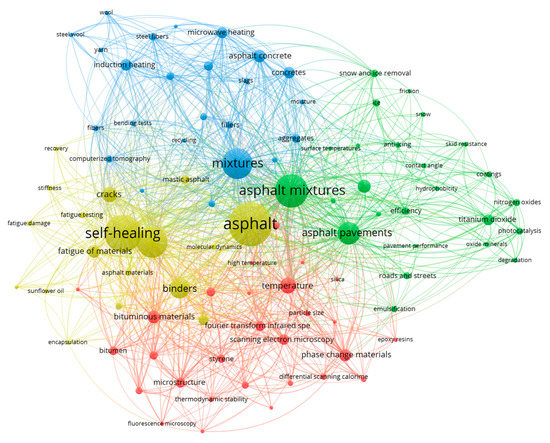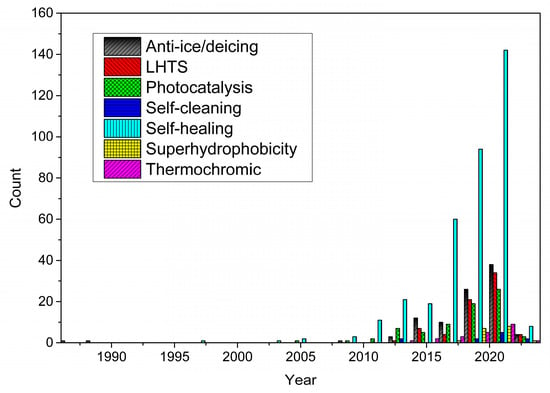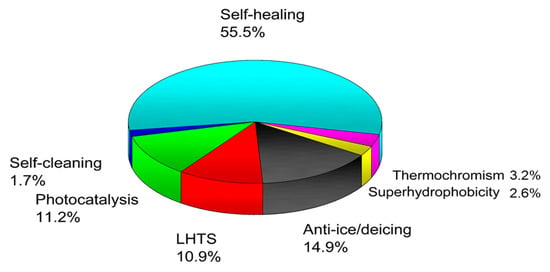You're using an outdated browser. Please upgrade to a modern browser for the best experience.
Please note this is an old version of this entry, which may differ significantly from the current revision.
Subjects:
Engineering, Civil
A smart asphalt mixture holds new capabilities different from the original ones or can react to a stimulus. These capabilities can be categorized based on smartness or function: smartness, mechanical, electrical, optical, energy harvesting, electromagnetic wave/radiation shielding/absorbing, and water related.
- smart asphalt
- bibliometric analysis
- functionalization
- smart materials
1. Introduction
An asphalt pavement must withstand the high stresses induced by traffic and weather, as well as guarantee safe and comfortable rolling conditions with low cost and a low impact on the environment [1,2,3]. In recent years, the application of new capabilities has become an important subject in Materials Science. More recently, the Civil Engineering Area, particularly Transportation Engineering, has been exploring new capacities to be applied to asphalt pavement [1,4,5].
It is relevant to mention that most road pavements are built with material from the distillation of petroleum crude oils, the asphalt binder. Given that road pavements are close to people and cover a large area, accounting for more than 50% of the urban area comprising roads and parking lots, researchers in Transportation Engineering have started functionalizing asphalt mixtures. This approach provides them with new capabilities, consequently offering several social, environmental, and financial benefits [6,7,8,9].
The incorporation of new functionalities into asphalt mixtures offers an opportunity to enhance road safety. Snow and ice in winter are known to cause many traffic accidents due to the reduced friction between tires and pavement [10,11,12]. Current practices to mitigate this problem rely on deicing agents [13], and conductive materials in asphalt mixtures [12,14]. The first one can melt the ice and snow through a chemical process [15,16], while the second one should be associated with a microwave or an induction-heating machine to melt the ice/snow [17,18]. Superhydrophobic asphalt mixtures can also mitigate this problem [19,20]. By coating the asphalt surface with nano/microparticles, water droplets are repelled, and the ice/snow formation is avoided [20,21,22]. This approach provides safer roads during rain and low temperatures [20,23]. Moreover, the surface coating promotes an additional capability known as self-cleaning, which contributes to the removal of dirt particles over the asphalt surface. Self-cleaning is achieved on three types of surfaces: (i) superhydrophobic: water droplets roll on the surfaces and carry the dirt previously deposited; this phenomenon is known as the lotus flower effect [24]; (ii) superhydrophilic: the water droplets spread on the surface, making it more easily washed by the removal of the adsorbed dirt on its surface during rainy periods; and (iii) photocatalytic effect because the photocatalytic materials can degrade organic pollutants (such as oils and greases) [25,26]. In this way, the self-cleaning property can contribute to the reduction of accidents in oil-spilled areas and dusty areas [1].
In addition to road safety, smart asphalt mixtures promise to mitigate air pollution and reduce the urban heat island (UHI) effect. Air pollution is one of the main environmental problems of large urban centers [27,28,29], and the need for environmentally friendly solutions to address the issue has become increasingly evident. This awareness is reflected by the prevalence of climate change conferences worldwide and substantial media coverage highlighting the effects and repercussions on human health. Among the various sources of air pollution, road traffic is one of the most important contributors that make vehicles [30,31] and roads themselves targets to reduce pollution. In the context of road surfaces, asphalt mixtures, when associated with photocatalysts, can promote air purification by photooxidation of contaminants [1,32,33,34]. Photocatalysts, semiconductor oxides such as TiO2 and ZnO, can oxidize pollutants, including, for instance, NOx and SO2, and degrade organic compounds in the presence of ultraviolet (UV) light and humidity [1,22,33]. To mitigate air pollution levels, researchers are concerned about the application of photocatalytic capability on asphalt mixtures by coating with semiconductor nano/microparticles [6,35]. In the literature, some strategies can be highlighted when it comes to the immobilization of particles. These particles can be fixed over the asphalt surface by applying a stick material, such as resins [36] or even cement [37] before the application of the particle solution. The durability and by-products of this technology are still a gap in the literature and need to be studied.
UHI refers to the phenomenon where an urban is significantly warmer than its adjacent rural areas due to human actions. To minimize this issue, using thermochromic asphalt mixtures offers not only greater mechanical strength and increased resistance to aging for the pavement but also provides the capability to reduce heat absorption by changing their color [38,39,40]. In this sense, it is possible to impart better properties to the material since the black color of conventional asphalt roads absorbs a high percentage of sunlight, increasing its surface temperature and contributing to the warmer conditions in urban areas [39,41].
Another strategy to mitigate the UHI is developing Latent Heat Thermal Energy Storage (LHTS) capability using phase change materials (PCM) [42,43,44,45]. Reducing the magnitude of temperature fluctuations also benefits the mechanical properties of the asphalt mixtures, preventing rutting, and avoiding thermal cracks [1,45]. In general, cracking is one of the main pavement distresses, and it can be reduced by developing a self-healing capability, which acts in the microcracking phase [7,46,47]. Asphalt materials heal their own cracking during rest periods; however, this effect is very limited and is not enough to mitigate the damage processes. Nowadays, researchers are developing innovative methods to improve and optimize this capability by adding conductive materials, nanoparticles, ionomers, and microcapsules containing high content of maltenes [1,47].
In the last 10 years, the number of published scientific articles on the development of new capabilities to asphalt mixtures, i.e., smart asphalt, has been sharply increasing. The main capabilities applied to asphalt mixtures are photocatalytic, self-cleaning, self-healing, superhydrophobic, thermochromic, deicing/anti-icing, and latent heat thermal energy storage [1,6,12,47,48].
2. Most Frequent Terms of the Smart Asphalt Mixtures
The relationship between the index keywords of each considered document and their co-occurrence frequency is presented in Figure 2. The most relevant terms were repeated at least fifteen times (without duplicate or similar terms, for example, rheological properties and rheology or pavement and pavements). The results were organized into four main clusters. In the first one, the most frequent terms are “temperature”, “bituminous materials”, “phase change materials”, “scanning electron microscopy”, “microstructure”, and “Fourier Transform Infrared Spectroscopy”. The second presents as main terms “asphalt mixtures”, “asphalt pavements”, “pavements”, “titanium dioxide”, “snow and ice removal”, and “efficiency”. The third cluster enclosed the terms “mixtures”, “asphalt concrete”, “concretes”, “induction heating”, and “microwave heating”. The fourth comprised the terms: “asphalt”, “self-healing”, “self-healing materials”, “binders”, and “cracks”. The most central terms are the basic ones for asphalt researchers, such as “asphalt”, “mixtures”, “asphalt pavements”, and “temperature”, which present high relevance for all clusters. In general, it can be observed that there are some capabilities treated in combination or some that present similarities.

Figure 2. Co-occurence network of the most frequent terms of the smart asphalt mixtures.
It is important to clarify the terminology used in the field of asphalt research due that involves terms such as “bitumen”, “asphalt”, “binder”, and “asphalt mixture”. The use of these terminologies reflects a certain regional preference, where the term “asphalt” is commonly adopted by American researchers, while “bitumen” is chosen by Europeans. In American terminology, bitumen is a solid substance, ranging in color from brown to black, with a semi-solid consistency at typical ambient temperature. They consist of a complex mixture of heavy hydrocarbons and their derivatives [67]. Asphalt is a mixture of hydrocarbons derived from petroleum naturally or by distillation, with bitumen being its main component. It can also contain small amounts of other materials such as oxygen, nitrogen, and sulfur. Therefore, asphalt is a bituminous material because it has bitumen [68].
The term “binder” refers to a material that is used to hold the aggregates together in a mixture. The binder can be made of asphalt, being called asphalt binder. It is typically made up of bitumen or asphalt but can also include additives or modifiers to enhance its performance and properties [69]. Thus, the asphalt binder provides cohesion, strength, and durability to the asphalt pavement [70]. Among the asphalt binders, there are asphalt cement, asphalt cutbacks, foamed asphalt, and asphalt emulsions, among others. Usually, the generic term asphalt binder is used to represent the principal binding agent, the asphalt cement. Finally, the asphalt mixture is an American term used to determine the mix of aggregates with the asphalt binder commonly used for constructing asphalt pavements and roads [71]. However, in some cases, asphalt only can refer to the asphalt mixtures.
The variation in terminologies related to asphalt research can be influenced by factors such as geography, cultural traditions, historical developments, technical differences, and academic influence. For example, sometimes the terminology asphalt can be used to represent the asphalt mixture or the asphalt binder. The term asphalt is commonly adopted by American researchers, while bitumen is used by Europeans. Additionally, industry norms, regulations, and evolving language can also contribute to the diverse terminological landscape within the field.
Photocatalytic and superhydrophobic (referred to by the terms contact angle and hydrophobicity) capabilities are close to each other, probably due to their combination of effects (all included in the second cluster). Moreover, this water-related capability, having as its main functionalization goal the removal of snow and ice that is related to the anti-ice/deicing capability, is usually applied with conductive materials such as steel fibers, wool, and recycled materials, such as slags, which are activated by the microwave of induction heating or even by additives containing salts (included in the third cluster). The anti-ice/deicing capability is also related to self-healing, thus showing the vicinity of the fourth cluster. Regarding self-healing, it can be functionalized by these types of conductive materials, but also by nanomaterials or even by oils (materials with high content of maltenes). All techniques aim to heal the cracks of the asphalt binder (bituminous materials, bitumen, and binders), which means that it presents nearness to the first cluster. The first cluster is more related to chemical, thermal, and microsurface analyses, totally associated with PCM. These tests are essential for nanomaterials, such as oxide minerals (including titanium dioxide). Encapsulation seems to be more related to self-healing than PCM, which can be an alternative for PCM leakage into the asphalt mixture. Slags are associated with anti-icing aspects but are highly recommended for self-healing as well.
The 45 most used keywords, considering the 626 documents in the database, were listed in Figure 3. The word that appeared the most was “asphalt”, followed by “asphalt mixture”. They appeared in 348 (56% of the total) and 216 (35% of the total) articles, respectively. In addition, considering the analysis of the top ten keywords, it is possible to highlight the interest of asphalt researchers in the self-healing capacity applied to asphalt mixtures. This is due to the presence of the words “self-healing materials”, “self-healing”, and “self-healing properties” occupying the third, fifth, and tenth positions.

Figure 3. The top 45 most frequently used keywords.
Terms such as “phase change materials” (related to LHTS), “snow and ice removal” and “ice” (usually related to anti-ice/deicing), and “titanium dioxide” and “nitrogen oxides” (usually related to photocatalysis) also appear, indicating their significant contribution to the literature. Characterization tests and processes, such as Scanning Electron Microscopy (SEM), Fourier Transform Infrared Spectroscopy (FTIR), microwave heating, induction heating, and dynamic shear rheometer, are also present. Properties like mechanical properties (specifically “fatigue of materials” and “tensile strength”) and thermal conductivity are emphasized. These occurrences may be associated with the current focus on the design and optimization of these capabilities. Future research may involve real context applications, environmental analysis, and modeling.
The practical application of smart asphalt mixtures may face barriers due to limited development and a lack of comprehensive studies that evaluate their environmental impacts, durability, economic benefits, and overall performance in real field conditions. Transitioning from laboratory environments to practical implementation requires robust evidence demonstrating their effectiveness in applied contexts. In the literature, only self-healing and anti-ice appear as the most developed capabilities in the field implementation. Self-healing focuses on the mechanical part of the and gains the attention of researchers. For the other capacities less developed, a Life Cycle Assessment (LCA) and Life Cycle Cost Analysis (LCCA) can contribute to information about the environmental impact and application and maintenance costs by incorporating new capabilities into the asphalt mixture. Some studies related to photocatalytic capacities show that this approach, nevertheless, is still incipient.
In addition, future research opportunities also are related to developing mixtures with multiple capacities. Few studies have explored the synergistic effects and integration of different functionalities to create asphalt mixtures with enhanced performance.
3. Overview of the Smartness/Capability
To assess the evolution of these capabilities over time and also assess their level of innovation, Figure 4 is presented. It can be observed that the concern about ice as pavements is not new since there are a few references related to this subject before the 1990s. Nevertheless, publications on the functionalization of asphalt mixtures from different points of view start significantly growing around 2012. The documents related to self-healing exponentially increased while the other ones did not follow this scientific interest. Anti-ice/deicing, LHTS, and photocatalysis seem to increase with similar scientific interest seen by equivalent evolution in recent years. It is observed that thermochromism, superhydrophobicity, and self-cleaning capabilities are the most innovative ones, as there are just a few numbers of publications. It is possible to conclude that self-healing is the most relevant and developed capability applied to asphalt mixtures with a sharp increase in interest from 2017.

Figure 4. Evolution of smartness/capability with time.
For a more accurate analysis, the relative contribution of each capability (i.e., each capability’s significance for the database) is displayed in Figure 5. Self-healing has the highest contribution to the database at 55.5%, while the others have less than 20%. Anti-ice/deicing is the second most targeted capability (14.9%), followed by photocatalysis and LHTS, each with 11.2%. Self-cleaning, superhydrophobicity, and thermochromism have only 1.7%, 2.6%, and 3.2% contributions, respectively, confirming that these functionalization processes are indeed innovative. Compared to self-healing, this may also indicate that researchers have no or do not yet have such interest in these topics.

Figure 5. Percentage of each smartness/capability.
This entry is adapted from the peer-reviewed paper 10.3390/coatings13081396
This entry is offline, you can click here to edit this entry!
